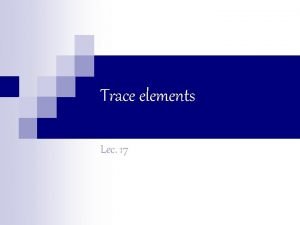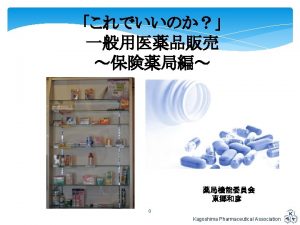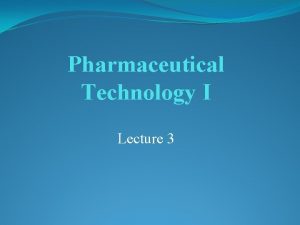Pharmaceutical Technology Lec 7 and 8 Dr Athmar











- Slides: 11

Pharmaceutical Technology Lec 7 and 8 Dr Athmar Dhahir Habeeb Ph. D in Industrial pharmacy and pharmaceutical formulations athmar 1978@yahoo. com

Principles of mixing �Adequate mixing is important �Mixing combined two factors Adequate flow of vehicle within the container to ensure uniform distribution of particles in the vehicle Sufficient shear within the system to achieve dispersion of individual particles rather than agglomeration �Factors involved in efficient mixing 1. Viscosity of the vehicle 2. Impeller shape, size, speed, location in the container and presence or absence of baffles. 3. Properties of the solid phase

Preparation of suspension Small scale production Large scale production Mortar and pestle • Levigation of insoluble drug with portion of suspending agent previously dispersed in water to form mucilage • Surface active agents (levigating agent such as PG or glycerin) • When a smooth past is formed the rest of the vehicle added in divided portions • Soluble drugs, flavouring agents, colouring materials added in the diluting portion of the vehicle • Transfer to graduate cylinder and complete the volume • Non-absorbing liquid (alcohol, PG or glycerin) • Methyl cellulose (suspending agent) Large mixing tanks fitted with variable speed stirring device such as propeller or a turbine impeller. Invariably the product is then passed through a homogenizer or colloid mill which operates on a continuous flow basis. Q/ Often 2 -step homogenization process is required is suspension preparation?

Physical properties of dispersed particles � The main problem with suspensions is to have uniform dispersion of particles at the time patient use the product (physical stability). Factors affecting physical stability particle-particle interactions play important role in flocculation /deflocculation mechanism particle-vehicle interactions significant in wetting and dispersing particles � particle-vehicle interactions Increase SA free surface energy increased Agglomeration into large masses ΔF = γxl ΔA γxl interfacial tension ΔA Surface area Note: � the system is thermodynamically stable when ΔF equal zero � (SAA wetting agents) is used to reduce the excess surface free energy through surface tension reduction. (disperse particles and reduce tendency to flocculate)

The initial dispersion of the particles in a suspension constitutes the first important step in suspension formulation Types of powders based on their wettability • • Lyophobic Wetted with difficulty by the vehicle Tends to clump and float on the surface of the vehicle (ex: sulfur or Mg stearate in water) Increase wettability by passing through colloidal mill in the presence of wetting agent (alcohol, glycerin or any hygroscopic liquids) Wetting agents are used to displace air, disperse the particles and allow penetration of the vehicle into the powder mass Lyophilic (solvent attracting powders) • Easily wetted by the vehicle • (ex: talc or Mg carbonate in water) Note: Although good dispersion through the use of wetting agent is desirable it can lead to caking with the sediment formed subsequently

particle-particle interactions � Attraction and repulsion between particles result from forces that reside at the particle surfaces (surface free energy and surface electrical charges and distribution of ions around particles) � Surface electrical charges sources (ionizable group on their surface, adsorption of ions from the surrounding solution) � Electrostatic repulsion between adjacent particles prevent them from adhering to one another � Presence of solvated sheath around the particles results in the dispersion of primary particles rather than aggregates (deflocculation) • Flocculation results from the collision and combination of primary particles in a suspension. • Not all collisions results in binding. • The greater the protective layer, the slower will be the rate of combination of the particles. Rate of collision Small particles (1 -5 μm) Brownian movement Large particles Mild agitation to increase flocculation rate

Sedimentation parameters • • Sedimentation volume F is defined as the ultimate volume of the sediment, Vu, divided by the original volume of the suspension, Vo, before settling F= Vu / Vo F could be = > < than 1 When F=1 flocculation equilibrium When F>1 flocs formed in the suspension is so loose and fluffy that the volume they are able to encompass is greater than the original volume of suspension Degree of flocculation β

Degree of flocculation β � Describe the relationship between the sedimentation volume of the flocculated suspension to the sedimentation volume of the same suspension when deflocculated � Large β indicates a flocculated suspension with floccules loosely held in an open scaffold. � small β indicates a highly condensed sediment � The lower value is 1 which indicates that no flocculation in the system � factors influencing β includes shape and size of the suspension particles and distribution of sizes � Temperature, density and viscosity have less effect

SEDIMENTATION RATE OF THE PARTICLES OF A SUSPENSION �The various factors involved in the rate of settling of the particles of a suspension are included in the equation of Stokes law �It is derived from an ideal situation in which uniform spherical particles in a very diluted suspension settle without producing turbulence , without colliding with other particles of the suspenoid and without chemical or physical attraction or affinity for dispersion medium























